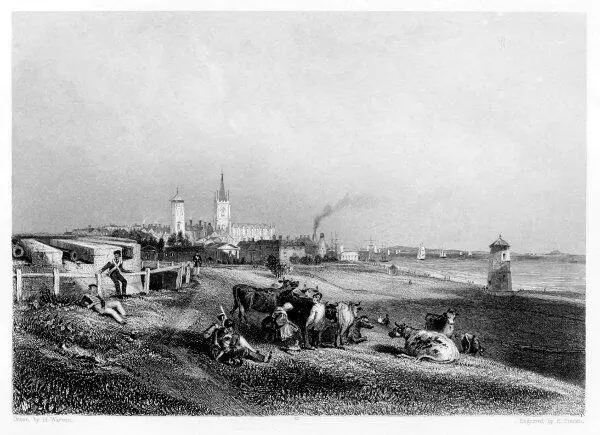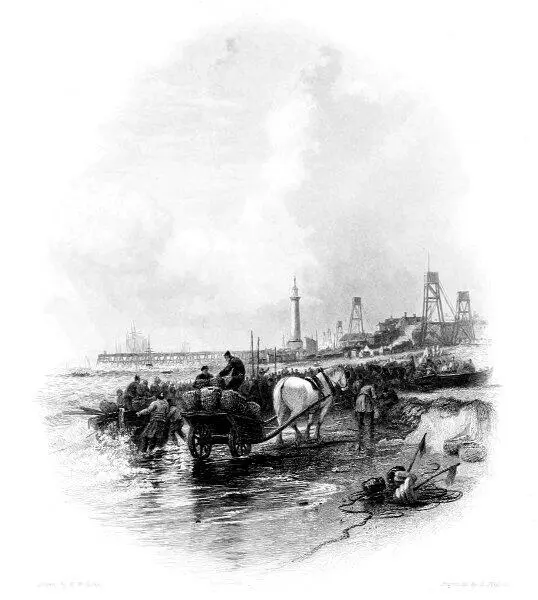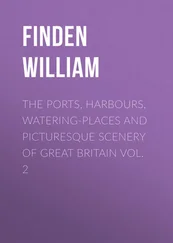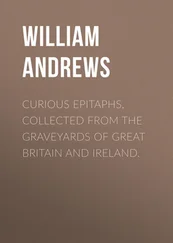After six years of incessant labour, it was happily brought to a successful termination under the direction of the late John Rennie, Esq., of whose genius as an architect it is a splendid monument. The opening of the bridge took place on the 1st of August, 1831, and gave occasion to a magnificent festival, which was honoured with the presence of his late Majesty William the Fourth and Queen Adelaide, the Lord Mayor, and all most remarkable for rank and station who were at that time in London. The ceremony was of the most gorgeous and gratifying description; and the water-pageant which accompanied it was the finest ever remembered on the Thames. The bridge was lined with tents and marquees, from which proudly floated the national standard, with numerous flags of societies and corporations, which gave the whole a strikingly gala-like effect. Under these a superb déjeûner , consisting of all the luxuries of the season, was served to the numerous assembly; and, to give additional novelty to the scene, Mr. C. Green, the celebrated aëronaut, ascended from the bridge in his balloon, much to the gratification of the spectators.
Immediately adjoining the Bridge, on the right, is the Steam-packet Wharf, which, from the constant landing and embarkation of passengers to and from all parts of the river, is a scene of uninterrupted stir and animation. On the left are the Bridges of Southwark and Blackfriars, with the magnificent Cathedral of St. Paul's in the centre of the picture.
The Monument (a conspicuous object on the right hand of the engraving) is a magnificent pillar, erected to commemorate the great fire of the city of London, in 1666, on the spot where it first began. It is of the fluted Doric order, and the material employed in its erection is Portland-stone of the best quality. It is one of the boldest specimens of the kind ever attempted, being two hundred and two feet in height, and fifteen in diameter, and stands on a pedestal forty feet high and twenty-one feet square; and within the shaft is a spiral staircase, consisting of three hundred and forty-five steps, formed of black marble. It was begun in 1671, but not completed till seven years after, as the great demand for stone in the restoration of London and the Cathedral of St. Paul's absorbed nearly all that the Portland quarries could furnish. Mr. Elmes, in his Life of Sir Christopher Wren , informs us that the Monument was at first used by the members of the Royal Society for astronomical experiments; but was abandoned on account of its vibrations being too great for the nicety required in their observations. This occasioned a report—extensively circulated at one time—that it was unsafe; but its sound foundation and scientific construction may bid defiance to all attacks, but those of earthquakes, for centuries to come.
This View of the Metropolis, from Southwark, is exceedingly grand and impressive, and presents a faithful picture of the every-day scenes which are here passing before the eyes of the spectator—dazzling his eye, and filling his mind with those images of unbounded wealth, power, and magnificence, of which there is no precedent in ancient or modern history.
 HARWICH. ESSEX.
HARWICH. ESSEX.
Table of Contents
Harwich is in the county of Essex, and lies on the south side of the estuary formed by the confluence of the Stour and the Orwell, about sixty-two miles to the north-eastward of London. The view in the engraving is taken from the southward, and comprises three of the most conspicuous objects in the town—the church, which is of modern erection, and the upper and the lower light-houses. In the distance, to the right, is perceived Landguard Fort, which lies on the Suffolk shore, on the opposite side of the channel.
In 1318, Harwich was incorporated by Edward II., at the request of his brother, Thomas de Brotherton, Earl of Norfolk. In 1347, the town supplied 14 ships and 183 mariners to the grand fleet of Edward III.; and in the 17th and 18th years of that king's reign, Harwich returned two members to Parliament; but the exercise of this privilege was discontinued till 1616, when it was restored by James I.
The trade of Harwich never appears to have been extensive; and its prosperity seems to have greatly depended on the Post-office packets, which formerly used to sail from the place with passengers and letters for the northern parts of Europe. The introduction of steam-packets has, however, rendered Harwich a place of no further importance as a packet-station, and for several years past the town has been in a declining state. The fishery, which formerly contributed to the prosperity of the place, has greatly diminished since the commencement of the present century. Harwich is the only harbour between Yarmouth Roads and the mouth of the Thames that is capable of affording refuge, in gales of wind from the eastward, to vessels navigating the eastern coast. During the prevalence of strong north-east winds, sometimes from 200 to 300 light colliers, and other vessels proceeding northward, are to be seen anchored in the harbour.
On the south of the town a cliff divides Orwell Haven from the bay, that extends to Walton-on-Naze. This cliff is observed to be constantly giving way to the action of the sea, which, it is expected, will at some future period force a passage to the opposite shore, and insulate Harwich and its vicinity. The cliff contains many acres of land, and its greatest height is about fifty feet. At the bottom, a bed of clay, of a bluish colour, about one foot thick, is succeeded by a bed of stone of nearly the same colour and thickness. Within the latter, shells and petrifactions, of various descriptions, have been found embedded. Above the stone are several beds of clay similar to that under the stone, rising to more than twenty feet. This clay, on exposure to the air, hardens into stone, and the streets of Harwich are paved with it. The town walls were formed of this material, as were also the castles of Orford and Framlingham.
During the fashionable season the town is visited for sea-bathing, and excellent accommodations are now provided, bathing-machines having been introduced, and the private baths rendered most convenient. They stand in a large reservoir of sea water, which is changed at every tide, and supplied with fresh water every hour, by a contrivance on the principle of a natural syphon. In some of these baths, the water is made hot for invalids, who, if they have neither strength nor courage to plunge themselves into the water, are assisted with a chair. There are also vapour baths, and machinery to throw the sea water, either hot or cold, on any part of the body.
There is a delightful walk, called "the Lawn," much frequented in fine weather as a promenade; and not far distant from it is the Beacon Cliff, on which were formerly the signal-house and telegraph, which were, some time ago, destroyed by the encroachments of the sea. This eminence commands a grand, interesting, and extensive prospect. Parties are also frequently made by the visitors for sailing or steaming up the Orwell and Stour, and making excursions on the bosom of the ocean. The scenery of the Orwell possesses peculiar interest, the banks being studded with elegant villas and pleasure grounds.
 YARMOUTH. NORFOLK.
YARMOUTH. NORFOLK.
Table of Contents
Yarmouth, in the county of Norfolk, sometimes called Great Yarmouth, to distinguish it from Yarmouth in the Isle of Wight, lies about 123 miles north-east of London, and about twenty-four to the eastward of Norwich. In the Vignette Engraving, from a beautiful painting by E. W. Cooke, the view is taken from the shore a little to the northward of the Jetty, which is seen extending into the sea. Nearly in the centre of the engraving is seen the column erected by the county of Norfolk to the memory of Nelson; and to the right are perceived several look-outs , like so many elevated scaffolds, from which, as the shore is very low, the pilots are enabled to take a wider survey when looking out for ships which may require their assistance.
Читать дальше

 HARWICH. ESSEX.
HARWICH. ESSEX. YARMOUTH. NORFOLK.
YARMOUTH. NORFOLK.










